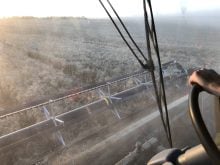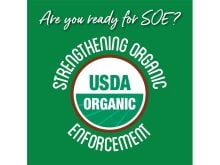MARTENSVILLE, Sask. – Garry and Pat Wallman’s dairy herd had the highest quality milk in the province last year but neither of them likes to drink the stuff.
Garry prefers juice and Pat drinks skim milk reluctantly to prevent bone problems.
But other people like their milk. The Wallman herd has been in the top 10 in Saskatchewan for quality for the past decade. In the family room of their house, the television set holds three gold metal cups or cows standing atop wooden bases. There are more trophies in another corner and plaques cover one wall.
Read Also

U.S. bill could keep out Canadian truckers
The Protecting America’s Roads Act, which was tabled in the U.S. House of Representatives at the beginning of October, would “rid the country of illegal immigrant commercial truck drivers and ineligible foreign nationals.”
How do they win such accolades? Garry says it is because they watch their cattle closely. Any illness or unusual behavior is dealt with quickly. The Wallmans also keep their milking equipment in good repair and credit their three employees for their gentleness with the cows.
Tender loving care
The couple keep a herd of 50, mainly Holstein crossbreeds. Garry says the leaders in the herd are a couple of Brown Swiss crosses, who know enough to head for shelter during summer storms. Not the Holsteins – they’re stupid, he says. And besides, “papers don’t make milk,” it’s the care that does.
While the herd is not purebred, the Wallmans use purebred bulls. They don’t bother with artificial insemination. Garry says they keep the bulls until they “turn ugly,” then they get more from larger dairy herds in the district north of Saskatoon. They sell off bull calves but keep most of the heifers.
Garry notes this year’s calving has resulted in almost a complete replacement herd of females. They like to use their own heifers because going to the auction mart can mean buying someone else’s troublesome beast.
In the barn at the end of a spring morning milking, the cows stand quietly on straw in two lines separated by a central alleyway. They are grouped four or five to the stall areas, each yoked in at the neck by wooden bars.
They all get a similar grain ration in the morning and wait while the milking is done, usually by 8:30 a.m. Then they are turned into a fenced chute that 130 metres away crosses the gravel road and ends at the field gate. Once all have ambled into the pasture, they can drink water, lick at the protein and mineral supplement tank or graze on the grass until they stroll back for evening milking at 5:30 p.m.
The routine changes in the winter – not in timing but in location. The Wallmans were the first in their area to try a winter shelter in which their cows can roam untied. The 15 x 36 metre Cover-all building cost $30,000 when erected two years ago but it has paid off.
“If not for that building I’d have folded her – it’s too much work,” said Garry, who has been milking cows for 39 years on this farm, which belonged to his parents.
The covered building acts like a mini-pasture and has cut the time needed to feed and water the herd in winter to one hour from the previous six. Switching to round bales also eased the workload. The Wallmans have shown their building – made by a company in nearby Hague – to about 50 visitors. It was an idea they first saw in the United States and figured would work for them. Now others in the area are trying it rather than keeping their herds tied up in barns all winter.
Pat joshes Garry about why he took so long to come up with good ideas. He replies: “When my back and legs gave out I got to sit on a hay bale and think awhile. That’s where I do my best.”
Their two daughters and son all have done their share of milking chores and none of them wants to take over the family business. But a nephew from the city has moved out to work on the farm and seems interested.
The Wallmans can’t imagine how any young person could start a dairy operation because of the cost. Quota is about $400 per kilogram of milk.
The Wallmans ship about 438,000 kg a year, not a large production when other herds in the area milk four times as many cows.
Then there are the hundreds of thousands of dollars that could be spent on computerized milking and feeding systems.
“I went around and looked at the big farmers and decided to keep it simple,” said Garry. “Some guys have spent $2 million to milk 200 cows.”
The Wallmans like a basic operation. Garry says they keep the cows fed, sheltered and dry. They have no plans to use BST if the milk-promoting hormone is legalized, nor do they take scrupulous records or buy expensive new machinery. They raise their herd’s feed – hay, oats and barley – on the six quarters of land they own or rent.
The fun side of life
Vacations are not common for dairy farmers but the Wallmans say with their help around they are able to get away more, usually short bus trips to casinos where they often run into other farmers.
Pat, who came from a mixed farm nearby, had never milked cows before she married Garry.
“I never minded it, doing the cleaning and washing (of cows and equipment),” she said. “Someone else can do the feeding and manure cleanup.”
But she fondly remembers the evening milkings with her kids when they would open up and talk about their school day. She thinks this is the main advantage of farm life for families.
















